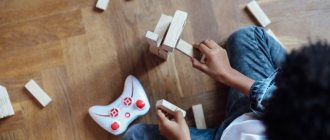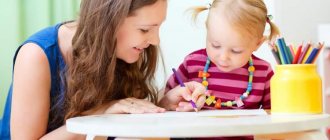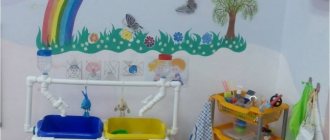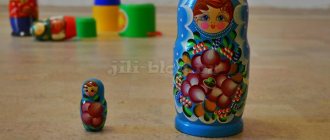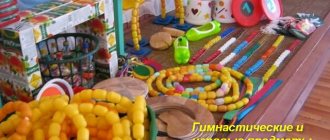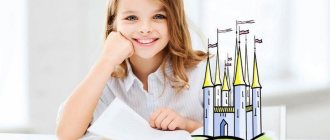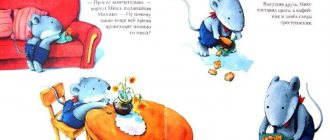By the age of three, every child should already have mastered the basic concepts that will help lay the basic foundation and develop intelligence. Many parents prefer to conduct classes at home, because children at 3 years old can be quite capricious. They do not yet know how to communicate with peers, are afraid to be in study groups and do not know how to maintain silence. Three-year-olds often look around and try to correct each other's answer, even if the answer was given correctly.
So, what activities should be done with three-year-olds?
First of all, math classes:
What should the baby learn?
- count to five;
- show your child simple geometric shapes: circle, square, triangle;
- teach your child to compare: more-less, better-worse;
- teach how to select pairs.
Please take into account that at three years old a child cannot concentrate on one subject for a long time. So during the day it is better to have 3-4 lessons of 15-20 minutes each than one hour-long lesson. Buy educational cards, counting sticks, puzzles and copybooks for educational activities.
Children at three years old can still put material in their mouth and chew paper, so it is better to laminate the cards. Otherwise, you will prepare a new set for each lesson.
Try to play educational games according to the following scenario:
- Show your child a card with a simple image.
- ask him to tell him what he saw in the picture, how many objects, what they are.
- If you have 1 more set of cards on hand, ask your child to find a pair in the second set.
Classes of this type can be carried out not only at home, but also on the street. In the summer, you can play the game “Pirate Treasures” with your son or daughter. Hand your child a map with a route, mark a couple of places with a cross and let your little one look for treasures. Motivate your child, tell him that he must solve this problem and help him if problems arise.
And if you have several children at home, then you can arrange a real competition between them. Children will have fun, explore the world and learn interesting things.
And if it's cool outside, play this game right at home. Just hide all fragile items.
Puzzles
Select puzzles for three-year-olds so that the picture is large and clear. And to start, take puzzles of 2-3-4 parts.
You can make an educational puzzle at home yourself. Take the picture and cut it into several squares. While the baby is putting together a puzzle, he will learn new words and numbers, develop attention and fine motor skills.
Copybooks
Copybooks are useful for kids, if only to develop their hands. Thanks to this material, kids learn to write letters and numbers correctly and draw neat lines. Again, you need to select such copybooks so that the images are large enough and the lines are clear.
Coloring pages
All kids love coloring books. Therefore, parents can and should use coloring books quite often. This material can be used at home, on the street, and at a party. For three-year-old children, it is best to buy coloring books that contain the image of the number itself and its name (this way the child will also practice reading).
Speech development
Normally, a three-year-old child speaks about 1000 words well and can already speak well, so special attention should be paid to speech development. What can you do?
- Communicate with your child as much as possible, be interested in what he says.
- Perform articulation exercises daily. This will help you place the speech sounds correctly.
- Discuss the story pictures. A collection of fairy tales by Vladimir Suteev is ideal for classes.
- Learn poems and songs. Poetic riddles are a hit with kids.
Speech development is positively influenced by games and exercises that involve fine motor skills , for example:
- all kinds of games with cereals, beans, buttons, sand, shells, pasta, etc.;
- fastening buttons, lacing;
- finger gymnastics;
- origami;
- games with water.
Musical activities help develop speech hearing: singing, guessing familiar sounds, playing musical instruments, guessing songs, singing vowel sounds.
Logic classes:
What should a child of 3 years old be able to do?
- find and explain the error;
- see similarities and differences;
- remember pictures and words;
- concentrate attention.
Three-year-old children move a lot and cannot sit still for long. If they lack physical activity, the child begins to get irritated, cry and become hysterical. It is important for a parent to remember this when planning an activity with their baby. The maximum lesson time should be 20 minutes. Before classes, it is better to do a ten-minute physical warm-up.
After the lesson, praise your offspring. Tell him that he did well and that he deserves encouragement. As a reward, you can take your baby to the park or some playroom.
Try to interest your baby in playing associations and opposites. Such exercises are good for training reaction speed, speech skills, and logical thinking.
At this age, children perfectly understand and love fairy tales and different stories. Tell them more often and make some mistake on purpose, and let the baby find it. For example, you say that winter has come, and then in the middle of the fairy tale the heroes go to the forest to pick mushrooms and berries.
The following exercise perfectly develops the logic and imagination of children: you show the child several cards that are related in meaning. And then invite your child to add another card that would fit into the story. For example, you show cards of mom, dad and child, and your kid can add a cat or a dog or a beautiful house here. And let him try to explain why he added this card.
Environment and culture
I already understood the essence of the Montessori method, but my girl has grown up, and I simply don’t know what to offer for some new needs. My knowledge began to be lacking, so I took the course “Development and education of a child from 3 to 6 years old.” Below I will show you what I managed to do during training. I will complete the rest of the home activities as new points of interest for the child arise.
Previously, I gave my daughter information chaotically, but during the course I learned the structure of getting to know the world around me. That all ideas need to be materialized in order to be able to interact with objects. That a child after 3 years old needs to be led from simple to complex and from general to specific.
Now my daughter and I talk for a long time, observe and explore so that she can get to know physics, astronomy, biology and geography first-hand:
- We watch the moon, and my girl is always the first to notice the stars in the sky.
- When we wake up in the morning, we look out the window and discuss what the weather is like today.
- We conduct experiments in botany. Once I was doing a material on mathematics, I took 3 cones, and seeds fell out of them. We looked at them together and saw that they had blades like a helicopter. We discussed that they help seeds fly in the wind, and this makes the forest grow. This became the reason for studying the topic of why trees need seeds at all.
- Using the example of a dried rose, we saw where the stem, leaves, thorns are, and where the roots are. We pulled it out, planted spruce seeds in a pot, and now we are waiting for seedlings. I’ll make a sign, I’ll write the days on it and we’ll put a dash if nothing grows or a tick if sprouts appear.
And these are activity ideas for introducing a preschooler to geography: using a globe, we study land and water; using the world map we study continents and biomes (forest, sea, desert, mountains); using cards - national clothes, animals and traditions of different countries.
On the world map I tried to explain that the planet can be imagined as flat, but this is still difficult for a child a little over 3 years old. Now I’m preparing a story about the continents on cards
We have wonderful books about trees and birds (you can even listen to the singing of these birds). If I take these books and read them myself, Yulia joins in, but she doesn’t take them from the shelves. It’s good that she so clearly demonstrates the lack of a point of interest - it helps me choose other activities for development at home.
I recently bought a book about Marc Chagall at the museum. I plan to hold a presentation of cards with reproductions to begin to introduce the child to the history of art and instill taste.
Speech classes:
What should the baby learn?
- his sentences should consist of 5-6 words;
- he can say his first name, last name, and the names of his parents;
- knows how to distinguish objects by characteristics;
- understands the meaning of actions (walk, run, cry, search, play, etc.)
At home, you can invite your child to collect cubes or cards with letters so that he learns to collect words. In three-year-olds, the memory is not yet particularly developed, so give the tasks not difficult so that he can easily collect the hidden word.
How to exercise at home?
The developmental lesson should take place in suitable conditions: in good lighting, in a ventilated room. The TV and computer need to be turned off, toys should be put away so that nothing distracts the baby. Make sure your child has had a good night's sleep, is not tired, and is not hungry or thirsty. Try to have your classes regularly, at the same time, because three-year-olds are very sensitive to changes in routine.
If a child refuses to complete the proposed tasks, do not force him, occupy him with something else. After some time, try again, most likely it will be successful.
Household activities:
What should the baby learn?
- must be able to dress and undress independently;
- cut out various pictures;
- color pictures;
- must understand the basic rules of accuracy.
Parents often hang posters and pictures around the house with hygiene rules. Every time a baby passes by, he remembers and remembers that he needs to wash his face and brush his teeth regularly.
Try to develop creative skills in your son or daughter. Once every 1-2 months, organize holidays or celebrations at home, for which you need to prepare costumes, decorations, etc. Involve your baby in the preparation. Let him help you.
If you don’t have enough time to organize holidays, make crafts together from different materials. Remember to use pine cones, leaves, acorns and other natural materials.
Personal care
Hygiene. For easy access to the sink, we placed a stool and hung a faucet extension. A towel, toilet paper, a basin for dirty clothes - everything is at the child’s level. He uses an adult soap dispenser: he presses with one hand, and places the other palm towards the hole from which soap drips.
During training, I reorganized the storage:
- she laid out combs, elastic bands, beads, bracelets and hairpins in different baskets;
- added teeth cleaning supplies;
- My husband and I hung a lower mirror.
Now if there is silence at home, we understand that the child is in the bathroom.
Dressing yourself. I myself really love order and teach my child to do it. My daughter puts her things back in their place, sometimes we have to remind them or do it together. It is clear that her independence and self-confidence are directly related to the fact that the necessary things are always available.
In the hallway I hung hooks for outerwear and a backpack. Opposite on the shelves in the closet I placed a basket with hats and mittens. Underneath it are stored outdoor toys and a bucket with a sponge and cloth for washing shoes. At the entrance there is a shelf with shoes for the weather, the rest is stored in the nightstand, just like ours.
I organized the wardrobe and hallway areas during the course for children under 3 years old, now I’ve just made small changes to make it even more convenient for my daughter. For example, I added the Trugen stool from Ikea. Dressing on it is clearly better than just on the floor or on an adult sofa, where your feet don’t reach the floor. True, now my daughter also uses it as a ladder to climb onto the sofa.
Children's clothes are stored on hangers and in the chest of drawers. I tried to place things so that they were as visible as possible. The chest of drawers is divided into sections to make it easy to maintain order.
Cognitive activities:
What should the baby learn?
- know some animals;
- know some plants;
- distinguish a vegetable from a fruit, a berry from a mushroom;
- know and understand natural phenomena (rain, snow, sun);
- distinguish the time of year and day.
Prepare images of various animals, birds and plants. Try to choose images of those plants and animals that you can find in your area. Then during your next walk you can show them to your baby and tell them some interesting facts and stories about them.
Fun game 3 for memory development “To the Store” (all children’s favorite game)
Children love to play and play in the store.
The game develops auditory short-term memory
Description: Send your child to the store, ask him to remember everything he needs to buy. Start with 2 purchases, increasing their number to 4-5. Name objects from feminine use for girls, and masculine items for boys. It will be more interesting to play this way.
- Switch roles.
- Make toy money for the game.
- How to remember everything? For example, buy a chocolate bar, loaf, cookies, milk, sour cream? It’s better to eat sour cream with milk, we’ll buy chocolate for the baby, we eat soup with a loaf of bread, and dad loves cookies. Use your associations and it will be even more interesting to play.
Intellectual games for children 3-4 years old
- “Set the table.” The game will teach the baby to help his mother and also count. Moreover, you will have fun. Ask your child to help set the table, bring two spoons and forks for mom and dad, bring apples, etc.
- "Fold a square." Ten multi-colored squares of cardboard - each cut in random order. The kid must reconstruct and count how many pieces each figure consists of.
- "Autumn leaf fall." Collect different leaves during your walk. Trace their outline on paper. Then the baby must guess where which piece of paper is depicted, without attaching the last one to the drawing.
- “Correct the mistake.” Using pre-prepared “wrong” pictures, the child is asked to figure out what’s wrong with them. For example, a blue bear cub pecks at grains, the child must notice that bears have a different color, and this animal does not feast on grains.
- Educational game to expand vocabulary baby
A fun game "Tell me which one?" Explain to your child that each object has signs, do it in a positive way. For example, an apple is round, red, big, sweet. Put different objects in the box and invite the child to take them out one by one and name the signs. You can even make up a fairy tale using these items.
- “Who can do what?” A 3-year-old child already knows many animals, birds, and professions. Give him an animal or a profession, and he must say what this object can do.
Role-playing games for children 3-4 years old
- "Daughters and mothers."
- "Holiday". Prepare for a birthday together. Make surprise gifts for dad or grandma. Children happily prepare gifts for birthday people, help set the table, and then begin the main delicacy.
- "Home construction". A plot that allows you to expand your child’s horizons with knowledge about construction equipment and professions. The little ones are involved in the process of creating a beautiful interior and home comfort, the boys try on the role of the head of the family.
Sports activities:
Physical exercise is just as important for three-year-olds as intellectual exercise. When the child goes to school, he will be able to do all the exercises in physical education lessons. He will also be able to play outdoor games with classmates without any problems and will be able to show his endurance and dexterity. At this age, children strive to spend time with those with whom they find it interesting and fun. If your child is sedentary and inactive, the number of his friends may decrease sharply.
Start your morning with a simple invigorating exercise. Do some exercises to warm up your muscles and stretch. If you wish, you can start your morning with a run.
Girls love different dances, the main thing is that cheerful music is playing at this moment. Boys prefer playing with a ball. You can include all this in your daily routine and have fun together.
In any case, you will need all kinds of equipment to perform the exercises: small dumbbells, balls, a jump rope, hoops, and so on.
Three-year-old children are very inquisitive and smart. At this age, children develop their first habits. If you are able to correctly create a daily routine for your child and keep him busy with useful and educational exercises, your work will definitely be rewarded.
Games for 3-4 year old children to develop basic skills
English lessons for children 1-2 years old
Educational outdoor games house
1. Game “Overcome obstacles.” Build obstacles from toys, cubes, bottles, toys. The kid must overcome these obstacles and come to the start. If you have a bicycle at home, you can go through obstacles on a bicycle or scooter.
2. Dance games for children 3-4 years old
These games will be a real boon for the holidays with children. Also, if other children come to visit you, you can organize such games. Children love to have fun and dance, dance in circles.
"Pretend to be a monkey." The kids stand in a circle, with an adult leader standing in the center of the circle. The presenter shows the movements, and the children must repeat after him as accurately as possible.
Game No. 1 “Learning to count” (for kids 3-4 years old)
DESCRIPTION: An educational positive game that will make counting fun and interesting. With such a game you can play with your child at any free moment. You can print these pictures in advance and play at any time!
Attention! How to copy coloring pictures from our website?
- Choose any picture. Right-click on the picture.
- Select "Save Image As". Save it in a convenient folder and print it from there!
Learning colors with kids 3-4 years old!
Game No. 1. Game “Where is this color found?”
Goal: remembering colors. Equipment: multi-colored sheets corresponding to the rainbow.
Progress of the game: Show your child the color and ask him to remember where he saw such a color in nature, life, or in his toys.
For example, Red - Little Red Riding Hood, tomato, red car. Orange – orange, shoes. Yellow is the sun. Green – grass, leaf. Blue - sky. Blue —blue felt-tip pen. Violet – violet flower.
Game No. 2. Game “Draw a rainbow and remember the colors”
Game No. 3. Sort the toys by color and get a smiley face
Give your child the task of sorting objects - toys, books, pictures, small objects by color. Praise him when he does everything and give him an appreciative smile. He's great!
Game No. 4. Color the flower by color - each petal has its own color.
Fine motor skills of children 3-4 years old
Game No. 1 “Delicious porridge”
Speak and show movements. Let the child repeat after you. You can modify the movements. This very simple game will become your favorite. The child will learn a memory rhyme, perform movements to develop fine motor skills, and at the same time feed the doll.
I’ll cook porridge for the doll: (Rotate your hands.)
I will pour milk into a bowl (Clench your fist and make a movement as if pouring from a bottle.)
I'll put the cereal there (Make loose movements.)
And I'll put it on the stove. (Open your palms.)
The porridge will be good! (Clap your hands.)
Eat, doll, slowly. (Threaten with your finger.)
More finger games here
Game No. 2 - develops motor skills very well
We sculpt together with the child (from plasticine or dough)
Modeling is No. 1 in the development of fine motor skills in children aged 3-4 years. Children are interested in creating their own toys, figures, houses. We have selected for you a small collection of figures made of plasticine or dough.
Attention! How to copy coloring pictures from our website?
- Choose any picture. Right-click on the picture.
- Select "Save Image As". Save it in a convenient folder and print it from there!
Game No. 3 “Collect beads”
Stringing buttons, beads, pasta, dryers and anything else on a fishing line or thread is good for developing children's hands! Kids love this activity, because then they can wear this jewelry or give it to their mother. Start with objects that have a wider hole - this will make it easier for your baby to master this task at first. In summer, you can use berries as beads - rowan, viburnum, leaves, etc.
A selection of a wide variety of decorations for the development of motor skills
